Sales Order Document
Basic Data (1st page)
Basic data that create a document header are stated on the 1st page of a Sales Order document. The heading data (first three rows) are also displayed on the other pages of the document.
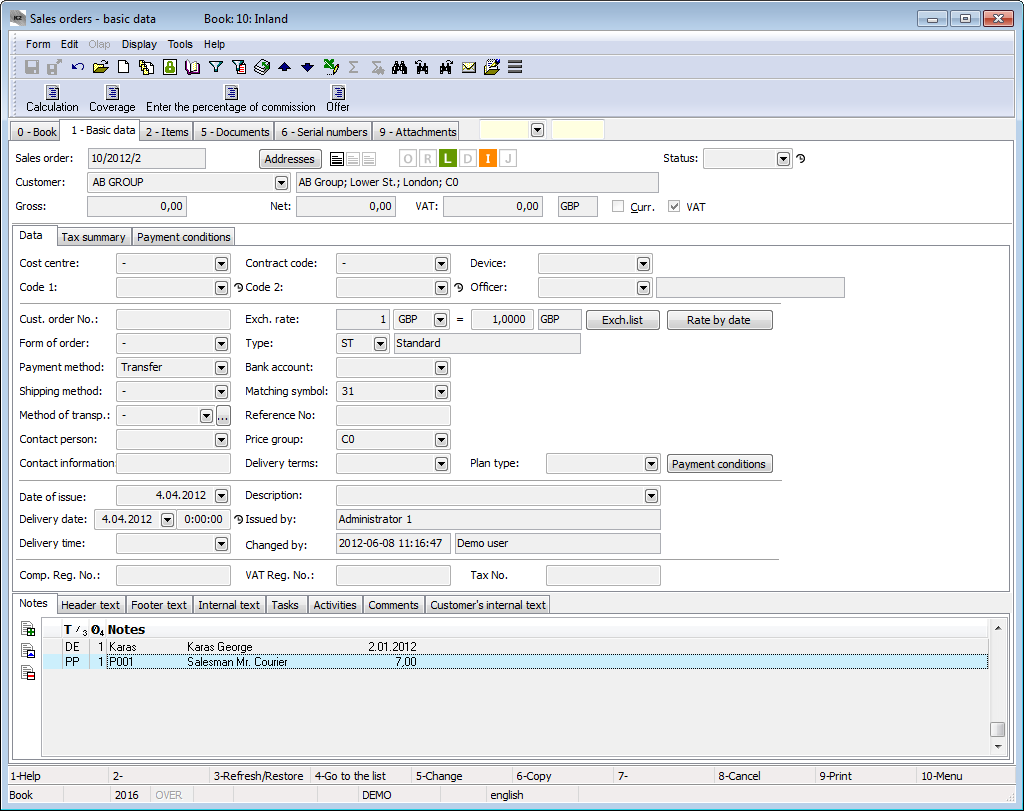
Picture: Sales Order - 1st page
Field description:
Sales Order |
The number and the business year of a Sales Order. |
Addresses |
This button activates the form for entering the addressee. The form can also be activated by the Ctrl+F4 key combination. For further information, see the Addressee chapter. |
Status |
The field for selecting from a code list. This field enables filtering of document according to the selected status. |
Customer |
Basic data about a customer – abbreviation, name, country, city, price group. A structure of these information is set in the Client Parameters. |
Prices |
The data about prices - the gross price, the net price, VAT and the currency code items. |
Currency |
The option is automatically checked according to the entered currency on a document. |
VAT |
The option indicates that the Sales Order is issued with VAT. |
Substitute Payment Mode |
The option defines whether a Sales Order is in the substitute payment mode. |
It is possible to assign random types and kinds of notes to Sales Orders; it is also possible to use the Header Text or the Footer text. Closer description of work with notes is stated in the the Basic Code Lists and Supporting K2 Modules – Notes chapter. The Internal Text tab serves for entering a text of any length to a Sales Order. If a text is entered, the "*" sign will be appear on the tab. Customer Internal Text tab serves to display the customer internal text only. There are also the Tasks and Activities tabs. Closer description of work with the folders is stated in the Tasks - Document Folder and Activities - Document Folder chapters.
Payment conditions can be displayed on the Payment Conditions tab and they can be edited with the same button.
Basic data of the header are divided into two tabs.
The Data tab contains basic information of the document header.
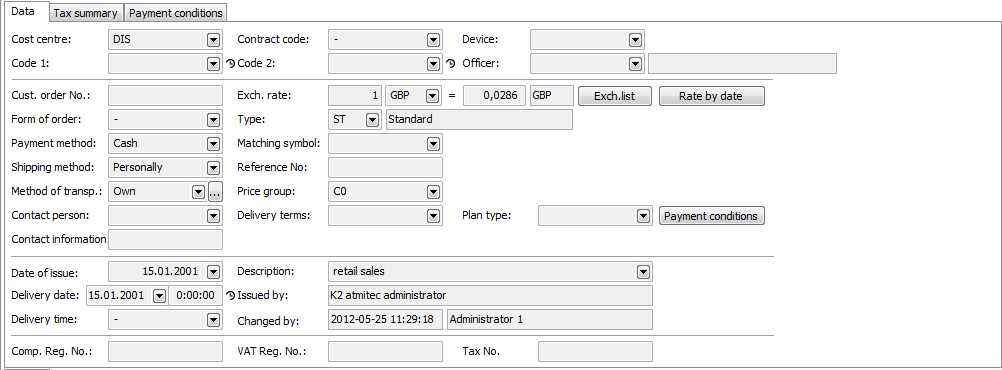
Picture: Data - Sales Order (1st page)
Field description:
Cost Centre |
The cost centre that has issued the Sales Order. |
Contract Code |
A contract code. |
Device |
A reference to the Device book. It is copied from a Sales Order into the subordinate documents. |
Code 1, Code 2, Officer |
The fields enable user identification, and eventually a link to the Officers book. Further description is stated in the Basic Code Lists - Code 1, Code 2, Officer chapter. |
Cust. Order. No. |
The field for typing the Order No. under which a Sales Order has been issued. |
Form of Order |
The way a customer has ordered the goods. |
Payment Method |
The method of payment for the withdrawn goods - in cash, by bank transfer, cash on delivery, etc. It is the user code list. By ticking the Cash On Delivery option on the 1st page of the record, it is possible to determine that the selected payment method is "cash on delivery". This flag is used to determine the cash on delivery in the Consignments module. By checking the Cash on Delivery option on the 1st page of the record, it is possible to determine that the selected payment method is "cash on delivery". Based on the credit settings, cash payments do not have to enter the credit limits (see the 'Credits' section). Note: Payment method may influence Invoice rounding. For further description, see the Rounding of Domestic Invoices Depending on the Payment Method methodology. |
Method of Transport |
Method of transport of goods. If a record of the method of transport has the Shipping Method Assigned option active, you can enter only the records that are assigned to the particular method of transport into the Shipping Method field (a closer description at the Shipping Method field). The button |
Shipping Method |
Shipping method of goods. The records of shipping methods may be assigned to the records of Method of Transport. If a record of the method of transport has the Shipping Method Assigned option active, only the shipping methods that are assigned to the particular method of transport will be offered to select from into the document. The Service Code field is used for consignment communication with the 'Balikobot' company. |
Contact Person |
A person who has agreed the deal on the part of the customer. A reference to the Contact Persons book. After displaying the book of Contact Persons (e.g. with F12), a filter of only those contact persons who belong to the specific partner of the selected customer will appear. If the customer has not been selected during the choosing of a contact person yet, a list of all contact persons will appear. If the user enters a character (characters) into the Contact Person field and presses the Ctrl + Spacebar shortcut in the Contact Person field, only the contact persons from the whole book which start with the entered character will be offered (i.e. without a link to the selected partner of the customer) . |
Contact Information |
The field may remain empty or you can write in your own random text. |
Exchange Rate |
The currency for which a Sales Order has been issued. There is also an exchange rate for the recalculation between the basic currency and the currency of the Sales Order in this field. |
Exchange List |
This button opens the Exchange List where you can select from the defined exchange rates. Exchange rates are defined in the Currency code list. |
Exchange Rate According to Date |
This button fills in the exch. rate from the exchange list valid on a Sales Order's date of issue. It can be run in the Change mode only. |
Type |
The type of tax. It is filled into the document from the Suppl./Cust. card (if entered there), or from the Book of Sale. |
Bank Account |
The account that is set on a Customer card will be pre-filled in. |
Matching Symbol |
Data about a matching symbol. The symbol is further used in Accounting. |
Reference Number |
The reference number of a Sales Order. It can be created automatically according to the settings in the Books of Sale. |
Specific Symbol |
A specific symbol. |
Price Group |
A price group of a Sales order. The price group is automatically added according to the price group defined in the Suppl./Cust. card, and is further pasted into the Sales Order items. |
Delivery Terms |
The records of delivery terms. It is pre-filled with the data from a Customer card. |
Plan Type |
Selection from the Plan Type code list that serves to distinguish the planning documents from the actual documents. A plan type that is defined on the 1st page of the Book of Purchase/Sale in the Plan Type field is entered into new documents by default (see the Basic Code Lists and Supporting K2 Modules - Plan Type chapter). |
Comp. Reg. No. |
Comp. Reg. No. of a customer. If it is not defined here, the Comp. Reg. No. from a Customer card is applied. |
VAT Reg. No. |
VAT Reg. No. of a customer. If it is not defined here, the VAT Reg. No. from a Customer card is applied. |
Tax No. |
Tax number of a customer. If it is not entered, the tax No. from a Customer card is applied. |
Date of Issue |
The date of issue of a Sales Order. |
Delivery Date |
The date by which the goods must be delivered. The date from this field is pasted into the Desired Delivery field on the Sale Item form when inserting the sale item. |
Delivery Time |
The period within which the goods must be delivered. |
Description |
In order to be able to distinguish individual Sales Orders in the book, a description can be entered or a text from the code list can be selected. |
Issued By |
The name of the employee who has issued the Sales Order. |
Changed By |
The date and name of the employee who made the last change of the Sales Order. |
Payment Conditions |
The button serves to set the payment conditions of a particular Sales Order. A detailed description is stated in the Purchase and Sale Shared Elements - Payment Conditions chapter. |
There is a table of price recapitulation in the Tax Summary tab.

Picture: Tax Summary - Sales Order (1st page)
Documents (5th Page)
There is an overview of all documents that are linked to the Sales Order on the 5th page of a Sales Order. You can move between the individual documents by pressing Ctrl and the initial letter of the document simultaneously. The selected document can be also displayed by the Ctrl+Enter key combination.

Picture: Sales Orders - 5th page with the open Release Notes tab
External documents (9th page)
As with other documents in the K2 IS, it is possible to insert and link references to documents on the 9th page of Sales Orders. Closer description of work with ext. documents is provided in the chapter Basic Code Lists and Supporting K2 Modules - 9th Page.
Internal Sales Orders - Internal Reservation for Production
An Internal Sales Order is a document that forms an internal requirement for the production of a product or a semi-finished product. We create internal sales orders in the Books of Sale that has the Internal Sales Orders option checked. The value that defines this is an Internal Sales Order item is stored in the Sale item.
An Internal Sales Order item with a Reserving Card t and without a Job Card with Execution creates a production requirement in Coverage. These are the types of records:
- Int. Reservation - Req. (Internal Reservation for Production - Request) - unconfirmed reservation list
- Int. Reservation - Confirm. (Internal Reservation for Production - Confirmed) - confirmed reservation list
The value of these records in Coverage is positive and is added to the total coverage status. It represents future production - receipt to the warehouse.
The amount of internal reservations on products can be tracked in the Articles book using the Internal reservation column.
Functions of the Sales Orders Module Menu
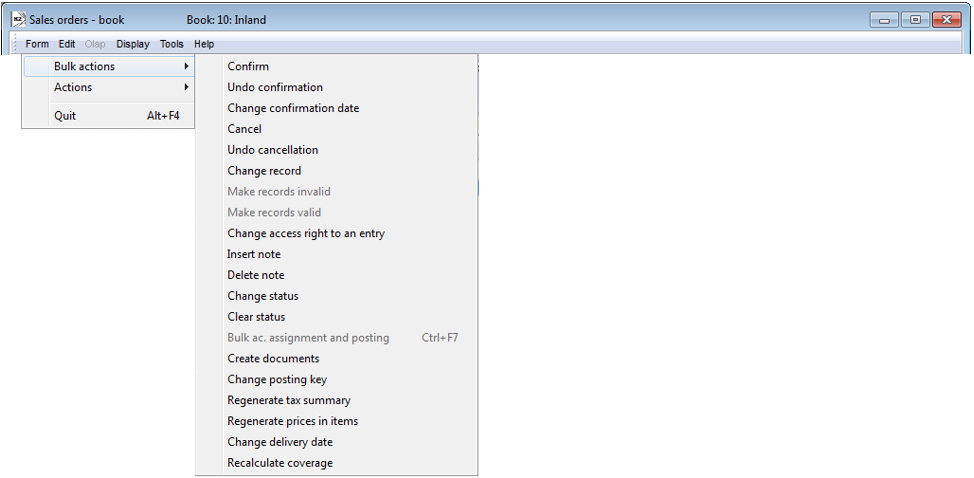
Picture: Functions of the Sales Orders module menu
Form - Bulk Actions:
Change Status |
Allows to change the Status field of the selected entries in bulk. |
Change Delivery Date |
The function enables to change the following data in unconfirmed Sales Orders:
The VAT and Gross amounts will be recalculated after changing the VAT rate. If there is an unconfirmed subordinate document on a Sales Order item, the amount on the subordinate document will also be changed. |
Recalculate Coverage |
This performs the evaluation of the coverage status of items of all documents that create the requirement of production or sale (items of the unconfirmed documents with the reservation flag). The list of recalculated articles is given by cards that are currently on the Sales Orders in the container. The status of coverage of the entire document, in Job Cards also the status of coverage of individual operations, is also calculated on the basis of the status of coverage of individual items. The evaluation of each item is executed to the requirement date. On the displayed form, it is necessary to set what conditions the recalculation has to be executed. The settings affect the loading of coverage data and the evaluation of coverage of the items. The settings of fields in the form is kept in memory. In universal forms. you can define Coverage Definition Patterns for recalculations. You can get into the book of Coverage Definition Patterns with the Shift+Insert key combination. A coverage definition pattern contains all settings necessary for the recalculation. Enter the saved patterns into the form for coverage recalculation. You may also add an unsaved definition with the Insert key. This way you can recalculate various items with various recalculation settings (e.g. various article categories) in one run.
The function is also available as a Shortcut that may be placed on the desktop of the program or to the Task Scheduler as an automatically running action. In this case, the coverage of all article cards is evaluated. It is distinguished between the Total Coverage and Coverage by Stock for the coverage of items / documents. While all the future movements are evaluated for the Total Coverage (it is evaluated according to the level, which is available in the Coverage of Demanded Article function), in the case of Coverage by Stock it is evaluated whether the item can be covered by the existing inventory in stock. Coverage of Items - Total (BFCovered)
Coverage of items - by stock (BFCoveredS)
Coverage of a Sales Order
|
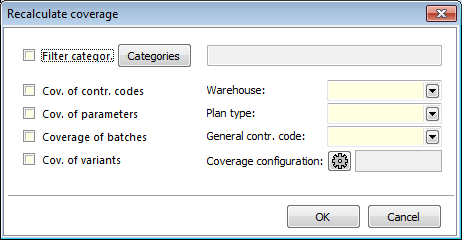
Picture: The Recalculate Coverage form
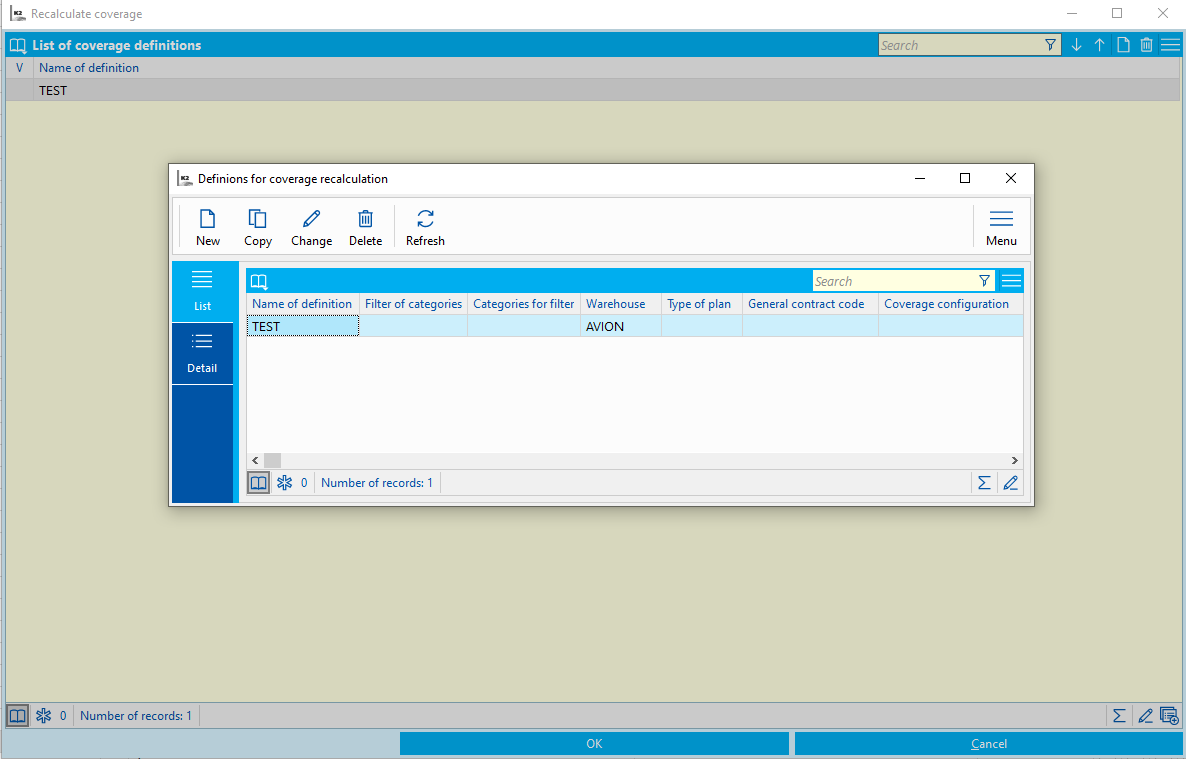
Picture: The Recalculate Coverage form and Coverage Definition Patterns in universal forms
Form - Actions - Documents:
Job Cards |
Finding a Job Card of a product. |
Actions:
Calculation of an Article Stock Price |
It offers an update of an article stock price. |
Functions for Sales Orders
Alt+F6 |
Release from handling unit. The function serves to insert all items from the selected handling unit into the document (page 2 in the Change mode). A Release Note will be automatically created for items. If a warehouse and a zone are pre-filled in the Book of Sale, the Release Note is preferentially created for this warehouse and zone. |
Ctrl+F8 |
Gantt Production Status chart is displayed - a chart showing the status of production. From page 0: all Sales Order items are loaded. From page 2 in the Browse mode: the current marked item or items indicated with an asterisk are loaded. Adetailed description of the chart is stated in the Gantt Production Status chapter. |
Ctrl+Shift+F6 |
For the current marked item, it opens the form of Wizard of the stock record and allows to enter the selected combination manually (contract code + batch + location) to the document item directly from the rows of document items. (2nd page, in the Change mode). |
Ctrl+Shift+F8 |
This creates a new Service Sheet for the currently marked item (page 2 in the Browse mode). It can be run from all Sales documents. |
Ctrl+Shift+F8 |
It opens the form Work in Progress by Workplaces (page 0, for current or marked Sales Orders). The function is available in the new user interface only. A closer description is provided in the chapter Sales Orders - Work in Progress by Workplaces. |
Cancel Sales Orders (F8)
If a Sales Order has already been saved (the number has been assigned to it), it cannot be deleted in any way. You can cancel it by pressing the F8 key. A cancelled Sales Order remains in the database with its content remaining undisturbed; it only has the flag of cancellation. Therefore, it is always possible to find out what was its content. It is not possible to change a cancelled Sales Order any more as in the case of confirmation.
If a Sales Order contains some confirmed subordinate documents, it cannot be cancelled. If a Sales Order contains some unconfirmed subordinate documents, the program will ask whether the subordinate documents should be cancelled as well. If the user has the right, then all documents will be cancelled at the same time.
Sales Orders - Work in Progress by Workplaces
The function shows the status of work in progress of individual Sales Order items by workplaces. The form of the function may be activated with the Ctrl+Shift+F8 keys over the list of Sales Orders (for current or asterisk-indicated records). The function is available in the new universal forms only.
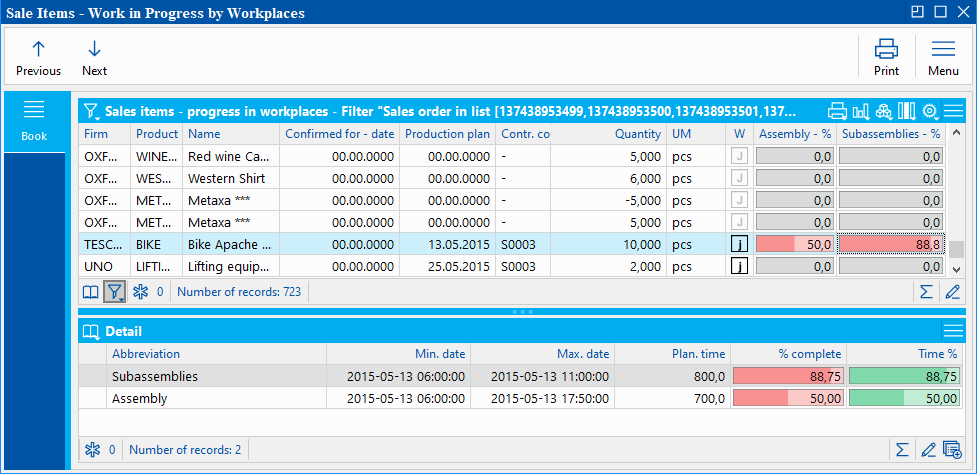
Picture: Sale Items - Work in Progress by Workplaces
Sale Items - Work in Progress by Workplaces
An overview of items of selected Sales Orders is displayed in the upper part of the form, the status of work in progress (the fulfillment percentage) at individual existing workplaces is provided in the columns. Apart from the value of the fulfillment percentage, the item status with regard to keeping up to the implementation dates is indicated by colours. Clicking on a specific unit of the table will show detailed information about the status.
|
Light red indicates the status where the production is in delay, which means that the current date is equal to or higher than the requested deadline from the Job Cards. Dark red indicates the actual percentage completion. |
|
Orange expresses the status where the production may be in delay. This means that the production has not begun yet, although the current date is higher than the requested date of beginning from the Job Cards. At the same time, the current date is not higher than or equal to the requested deadline. The production may still be finished in time (e.g. by adding a shift, increasing the number of resources, etc.). |
|
Light grey and the value 0 marks the workplace that does not participate in the production of the item. |
|
Dark grey and the value 100 marks a completed task - regardless of it being finished in time or not. |
|
White and the value 0 indicates the status where the production has not begun yet, while the current date is lower than the requested date of beginning. |
|
Light green means that the production is running according to the plan. It has already been started and the current date is within the interval of the requested date of beginning and the deadline. Dark green indicates the actual percentage completion. |
Detail
An overview of workplaces with additional information is displayed in the lower part of the currently indicated Sales Order item.
Min. Date, Max. Date |
The minimum date of start and the maximum deadline from the Job Cards of the given workplace. |
Complete % |
The percentage complete identical with the data in the upper table of a specific workplace. |
Time % |
The percentage of time spent on completing the task. |
Reports - Sales Orders
Statement of Sales Order
Process No.: ZAK014 |
Report ID: SZAK005 |
File: ZAK_VYP01.AM |
Report description: Statement of Sales Order |
||
Address in the tree: [Sale / Processing of Sales Orders] [Sales Orders] [Print documents - Lists] |
||
Report parameters:
SupressSum - No Yes - hides the total for items. |
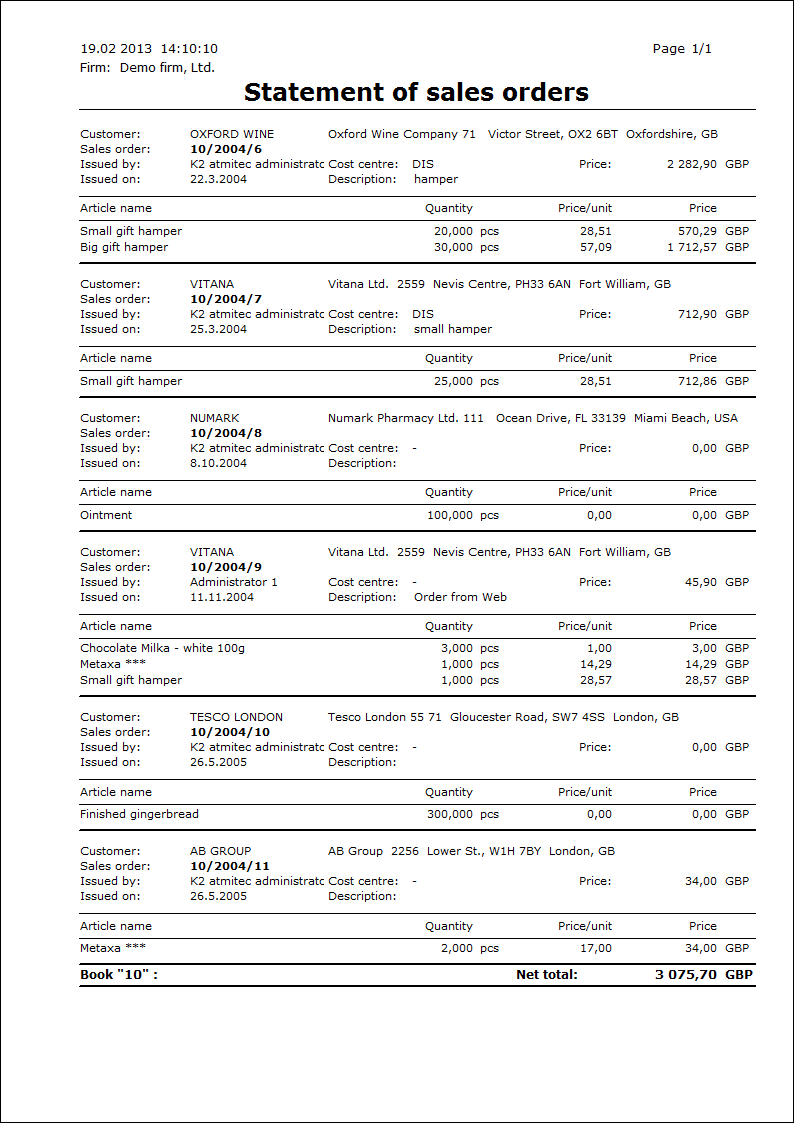
List of Sales Orders
Process No.: ZAK014 |
Report ID: SZAK003 |
File: ZAK_SEZ01.AM |
Report description: List of Sales Orders. |
||
Address in the tree: [Sale / Processing of Sales Orders] [Sales Orders] [Print documents - Lists] |
||
Report parameters:
ShowDocDescription - No Yes - displays document description. |
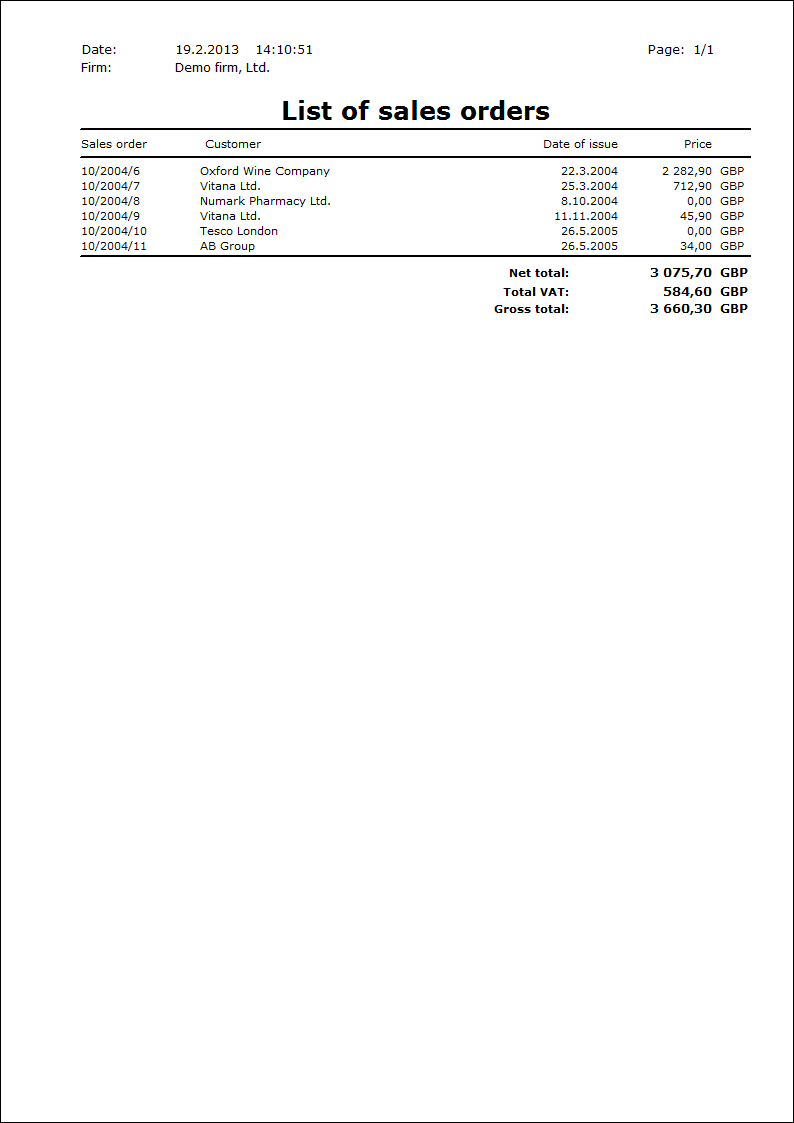
 next to the Method of Transport field is mainly related to e-shop. If there is an article where the
next to the Method of Transport field is mainly related to e-shop. If there is an article where the  : an item will be completely missed on the requirement date.
: an item will be completely missed on the requirement date.